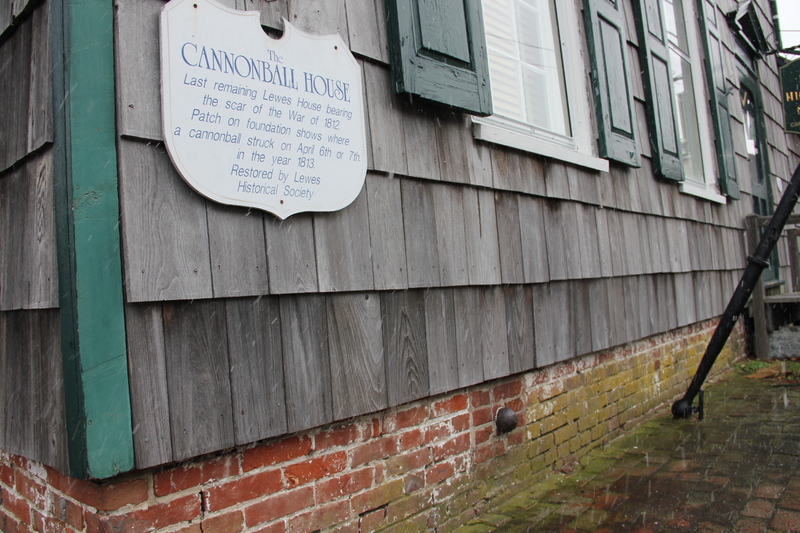Two hundred years ago this week, as the days lengthened and winter turned slowly to spring, the people of Lewes had little to cheer them. A menacing squadron of British vessels, led by Commodore John Poo Beresford’s 74-gun ship-of-the-line Poictiers, lay at anchor just offshore in the mouth of Delaware Bay. The U.S. and Britain were in the second year of the War of 1812. Beresford and his men were hungry and thirsty and were spoiling for a fight.
On March 16, the commander had sent messengers to shore demanding a veritable bull roast with all the trimmings. If the townspeople didn’t comply, he wrote, he would destroy the town.
Having flatly rejected Bereford’s polite but insistent demand, Lewes passed the next couple of weeks waiting for the commander to make good on his threat.
Here’s the larger picture. The U.S. had tried to remain neutral in Britain’s war with Napoleon’s France, but the British took the attitude that if you weren’t with them you were against them. The U.S. wasn’t about to turn its back on the French, who had helped the new nation win its war for independence. Meanwhile, the British naval fleet, the world’s strongest at the time, exercised its power on the open seas by targeting any vessels not allied with them.
Fed up with the British raiding its ships and stealing its sailors, the U.S. declared war on the British in June of 1812.
Gov. Joseph Haslet of Delaware immediately aligned himself with the federal government. “The crisis has come when we must convince the world that we know how to value our rights, and have means to enforce them,” wrote Haslet, according to Thomas Scharf’s 1888 History of Delaware.
As the U.S. began organizing militia and contracting with duPont’s powder works in Wilmington for ammunition to charge guns and cannons, its young navy began engaging British ships up and down the eastern seaboard. Commander Jacob Jones, who had been schooled in Lewes and once reportedly lived in the Ryves Holt House, became a national hero in October of 1812 when his Wasp defeated the HMS Frolic in a violent sea battle in the Caribbean. Still burying dead at sea and nursing wounds on the crippled Wasp and her prize, the Frolic, Jones had little time to celebrate. When the 74-gun Poictiers came over the horizon shortly thereafter – ironically the same ship and commander that would later show up in Lewes - Jones had nothing left to fight with and lost the Wasp and the Frolic to the British.
A few months later the British declared a blockade of the entire U.S. East Coast. With weather easing, the British fleet of 1813 moved into position to create its blockade and cut off the US from the rest of the world. By March, the blockade was complete, with Commodore Beresford’s Poictiers and the rest of his squadron anchored in the mouth of Delaware Bay off Lewes. That set the stage for what Mike DiPaolo of Lewes Historical Society calls the most important singular event in the town’s history.
“It was the last time that Delaware came under fire from a foreign enemy.”
Lewes rejects Beresford
Beresford’s March 16 letter to the First Magistrate of Lewes stated: “Sir: - As soon as you receive this, I must request you will send twenty live bullocks with a proportionate quantity of vegetables and hay to the ‘Poictiers,’ for the use of his Britannic Majesty’s squadron, now at this anchorage, which shall be immediately paid for at the Philadelphia prices. If you refuse to comply with this request, I shall be under the necessity of destroying your town.”
Scharf reports that backed by Gov. Haslet who immediately began sending 1,000 militia from across the state to head to Lewes’s aid, the people wasted little time in responding to Beresford. ”We solemnly refuse to commit legal or moral treason at your command,” they wrote back. “Do your worst.’”
The light at Cape Henlopen was extinguished; local pilots removed buoys in the bay to confound the British mariners, and Lewes prepared for the assault.
As March turned to April, Beresford sent another message to the town repeating his demand and adding fresh water to his list of needs. The town’s response remained the same. And when a British captain sent word advising Col. Samuel Boyer Davis – in charge of the defenses in Lewes - that the women and children should be taken out of town, he was told: “Col. Davis is a gallant man and has already taken care of the ladies.”
Late on the afternoon of April 6, nine vessels from the squadron ranging from launches to the frigate Belvidera bore down on Lewes and began showering the town with cannonballs, shot and the newly developed Congreve rockets. It was those same rockets from those early days of shock and awe that would eventually inspire Francis Scott Key to write about the rockets’ red glare in his “Star Spangled Banner,” which became the national anthem. For 22 hours, the assault on Lewes continued. When daylight came on April 7, boys from the town scurried after cannonballs that landed in sand and mud so they could be returned as fire from the cannons mounted along the bank of Lewes Creek where today’s 1812 Park stands. DiPaolo said the town’s fortifications stretched along Front Street all the way to where the Canalfront Park is now. “The bank there is a remnant of the fortifications built to defend against the British,” he said.
Scharf reports that the British fired an estimated 832 cannonballs, shells and rockets, striking a few houses, but causing little more damage. One report noted that the shelling had broken the leg of a pig and killed a chicken.
With the show of the militia as well as other stunts by the townspeople to feign a large force onshore, along with the absence of any white flag signaling surrender, the British apparently gave up on the idea of a land invasion. Instead, over the next several weeks, they resorted to making more stealthy nighttime visits up and down the coast to steal provisions and fill their casks with fresh water.
By summer, the Beresford-commanded fleet had weighed anchor to head off to other parts of the war in the Chesapeake.
News of the failed Lewes assault was toasted and published up and down the Eastern Seaboard. One of the wags of the day summed up the event with a little poem:
“The commodore and all his men,
wounded a pig and killed a hen.”





















































